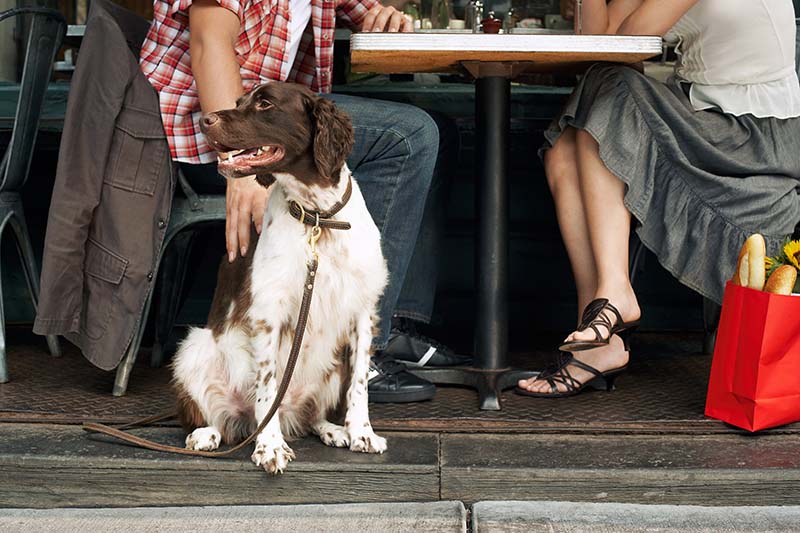Are Emotional Support Dogs Allowed in Restaurants? 2024 Update

Updated on

Click to Skip Ahead
Owning an emotional support animal, or ESA, is one of the most common treatments for anxiety, phobias, and other serious mental health conditions. But unlike service dogs, emotional support dogs are not allowed in all public places, including restaurants. This is important to remember whenever you’re out in public with an ESA, especially when it comes to visiting your favorite eatery. Unless you visit a pet-friendly restaurant, the animal won’t be permitted inside the building.
Although they’re quickly growing in popularity, ESAs and their access rights are something that many people don’t fully understand. To explain why ESAs aren’t allowed in restaurants while service dogs are, this guide goes over the differences between the two types of assistance animals and their rights under the Americans with Disabilities Act (ADA).
What Are Emotional Support Dogs?
Before we go into more detail about whether ESAs are allowed in restaurants, we need to touch on what makes them different from service dogs or pets. This will help you understand why there are limitations on where an ESA can accompany their handler.
A dog is one of the animals that can be an ESA. They provide comfort and companionship to their handler. This includes helping alleviate the effects of depression, anxiety, phobias, and loneliness.
Unlike with service dogs, any domesticated animal can be an ESA, which is why you can see dogs, cats, horses, and many other types of animals used for this role. You need to have a qualifying mental illness or disability and be diagnosed by a licensed therapist, psychiatrist, or other mental health professional to use an ESA legally.
However, beyond obedience, house training, socialization, and other training to ensure that your ESA behaves themselves in public settings, ESAs aren’t trained to perform specific tasks for their handlers. While they are working animals and do aid their handlers, they are not considered to be service dogs under the ADA. Unfortunately, this means they do not have the same rights as fully trained service dogs.

Are Emotional Support Animals Considered Service Dogs?
Many people get confused about the difference between ESAs and service animals. Before you can understand why ESAs aren’t allowed in restaurants, you need to understand the differences between the types of assistance dogs. There aren’t many, but these differences are what give service dogs public access rights, while ESAs need to follow a business’s or location’s pet policy.
Both ESAs and service dogs are working animals. However, their duties differ.
1. Service Dogs
A service dog is defined by the ADA as “a dog that is individually trained to do work or perform tasks for a person with a disability.” This means they have specific training that allows them to assist their handler. Their tasks are directly related to their handler’s disability and are often tasks that the handler cannot manage on their own.
A service dog’s tasks can include anything from providing medical alerts to helping ease the symptoms of anxiety attacks. They also do things like retrieve dropped items or medication, do room sweeps, turn lights off or on, and perform many other tasks that give their handler more independence.

2. Emotional Support Animals
An ESA isn’t trained to perform a specific task to aid their handler. Their purpose is to provide comfort or emotional support to their handler, but they don’t have any specific training that enables them to do this. It’s their presence that provides comfort rather than their ability to perform specific tasks. So, while they’re still assistance animals, they are also subject to pet policies in most public areas.
3. Psychiatric Service Dogs vs. ESAs
Now that you know the difference between ESAs and service dogs, you might be wondering why psychiatric service dogs aren’t considered to be ESAs. After all, the purpose of both a psychiatric service dog and an ESA is to provide support for handlers with mental health disabilities.
The difference is in the tasks that ESAs and psychiatric service dogs are expected to perform. For example, while the presence of an ESA can provide comfort to their handler during an anxiety attack, they’re not trained to alert their handler to an oncoming attack or interrupt self-destructive behavior resulting from PTSD. However, psychiatric service dogs are trained to interrupt and even help their handler avoid situations that could result in anxiety or panic attacks.

Are Emotional Support Animals Considered Pets?
The question of whether ESAs are pets is where it gets more confusing. Regardless of their species, ESAs are working animals. As a result, they fall somewhere between service dogs and pets. However, since ESAs aren’t protected by the ADA, they are classed as pets when it comes to pet policies and access rights in public spaces.
That said, ESAs are still assistance animals, so they do fall under acts that give them rights that regular pets don’t have. For example, the Fair Housing Act enables you to keep your ESA with you in a rented accommodation that would usually disallow or charge extra for pets.
The biggest difference between pets and ESAs is the fact that you need to qualify for an ESA. A licensed mental health professional needs to diagnose you with a mental health disability and prescribe the use of an ESA as a treatment. To use an ESA legally rather than as a pet, you need a professional and properly formatted prescription letter.

Are Emotional Support Dogs Allowed in Restaurants?
So, whether ESAs are allowed in restaurants depends on the location’s pet policy. While a service dog is allowed anywhere their handler is, unless their presence interferes with legitimate health and safety requirements (they wouldn’t be allowed in an operating theater, for example), an ESA has to abide by pet policies.
Some restaurants do allow pets as long as they’re well-behaved and housebroken and don’t disrupt the other guests. In this case, your ESA can join you inside a restaurant while you eat. However, if the restaurant has a “no pets” policy, you’ll need to eat outside if there’s available seating, leave your ESA at home, or choose a pet-friendly restaurant to visit instead.
It’s also important to remember that regardless of the pet policy, both ESAs and service dogs can be asked to leave if the animal isn’t housebroken or is being overly disruptive or aggressive or if the handler can’t control them.
Conclusion
For people with serious mental health conditions, emotional support animals can make the difference between never stepping outside and living a normal life. While ESAs are a prescribed treatment for many mental health conditions and provide comfort and reassurance to people who need it most, they are not trained to perform specific tasks and aren’t considered to be service dogs.
Unfortunately, this means they’re not permitted in places with “no pet” policies, which can include restaurants. If you’re not sure whether your ESA is welcome at your favorite eatery, call ahead to ask about the pet policy or wait for a warm, sunny day and sit outside instead.
Featured Image Credit: sirtravelalot, Shutterstock













